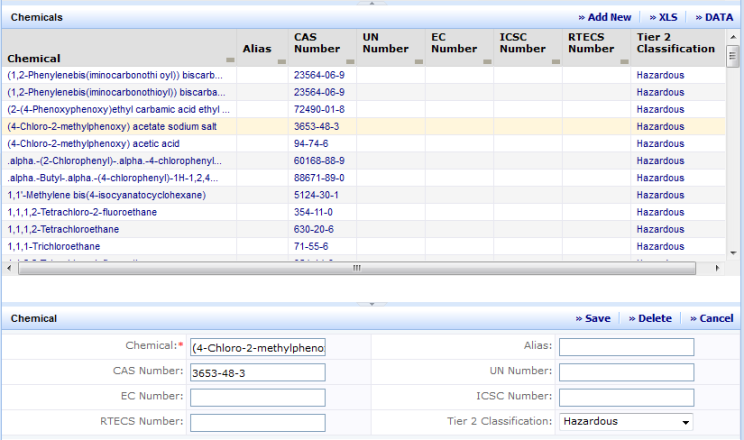
An MSDS defines the attributes of a hazardous material which may be a combination of chemicals. The chemical list is used by the MSDS application to assign constituent chemicals to each MSDS. Because chemical names are long and difficult to type, having a list of chemicals to pick from speeds up the data entry process. In addition to the chemical name, an assortment of standard identifiers can be entered to aid in finding a particular chemical. The Tier Two Classification is also included in the data to facilitate chemical inventory reporting.
Log into Web Central and navigate to the Define Companies task by selecting:

The Define Chemicals view has a has two parts, a grid showing a selection list of chemicals and an edit form where data are modified.
When the view is first presented, a grid listing at the top of the screen automatically lists all chemicals in the system up to the limit of the grid. It is likely that the number of chemicals in the system will be large (possibly in the thousands). Consequently, the number of chemicals that can be shown in the grid is limited for performance reasons. This means that you will probably need to filter the grid to view the chemicals of interest. An expanded mini-console in the grid allows you to filter or sort data on any of the displayed columns. For example, you might want to see all of the chemical names that contain "chloroethane" (enter %chloroethane% in the Chemical field and click on the filter funnel).
The edit form below the grid is activated by either selecting "Add New" or by clicking on a company in the grid. The columns in the edit form are shown in the table below along with a definition of the information to be entered.
|
Field |
Purpose |
|
Chemical |
(Required Field) The name of the chemical. This value must be unique. |
|
CAS Number |
CAS numbers are unique identifiers assigned by the Chemical Abstracts Service to chemicals including elements, isotopes, organic and inorganic compounds, organometallics, metals, nonstructurable materials. |
|
EC Number |
The European Commission number. It is a seven-digit code that is assigned to chemical substances that are commercially available within the European Union. |
|
RTECS Number |
The Registry of Toxic Effects of Chemical Substances identifier assigned by US National Institute of Occupational Safety and Health (NIOSH) to every chemical in the RTECS database. The identifier is a nine-character sequence of which the first two are alphabetic with the remainder numeric. |
|
Alias |
Another name by which the chemical may be known. |
|
UN Number |
United Nations number. A four-digit number assigned to potentially hazardous materials. UN numbers are used by emergency response personnel for identification of materials during transportation emergencies. UN numbers are internationally recognized. |
| ICSC Number | International Chemical Safety Card identifier. These cards provide essential health and safety information and often form part of education and training activities. ICSCs may also be used by agencies responding to chemical incidents. Information in an ICSC is peer-reviewed by the World Health Organization. |
| Tier 2 Classification |
Hazard classification provided by the EPA. This classification determines if a material is a candidate for Tier I or Tier II Chemical Inventory reporting. Possible values are:
|
To add a new chemical:
To edit data for an existing chemical:
To delete data for an existing chemical: